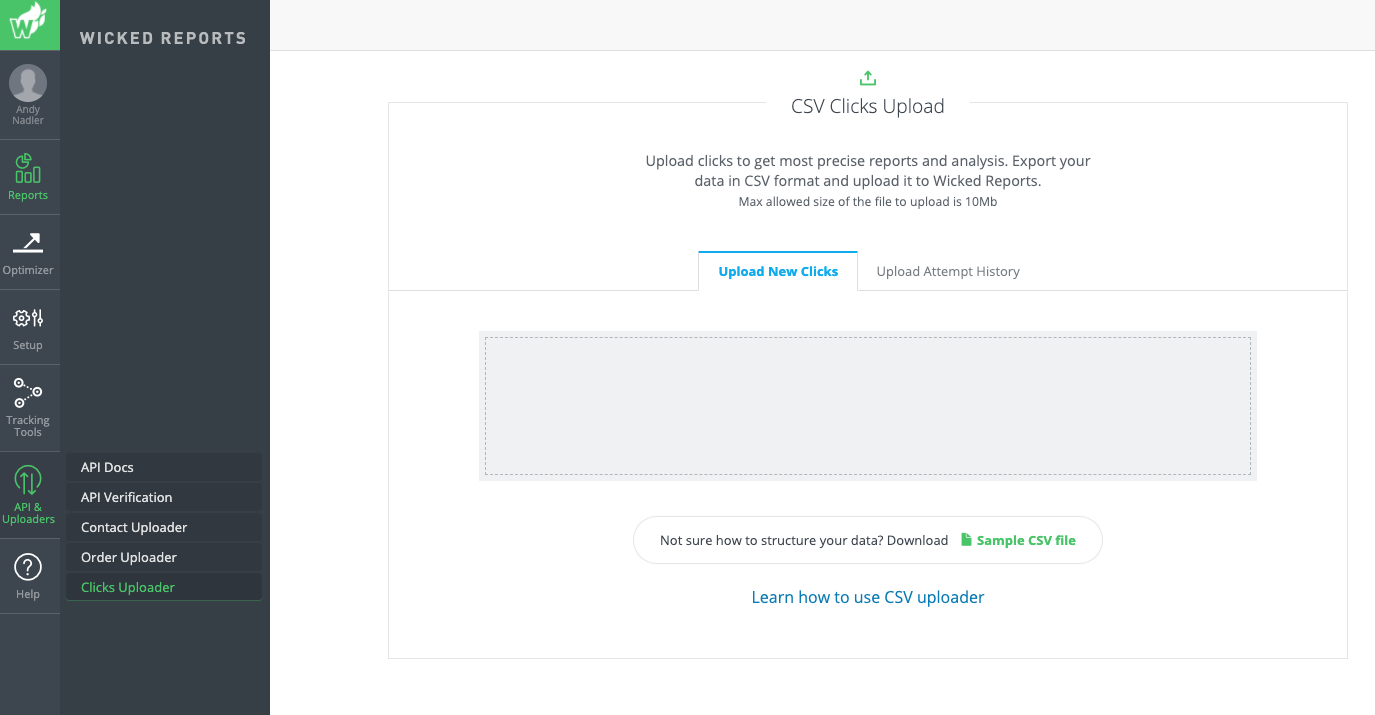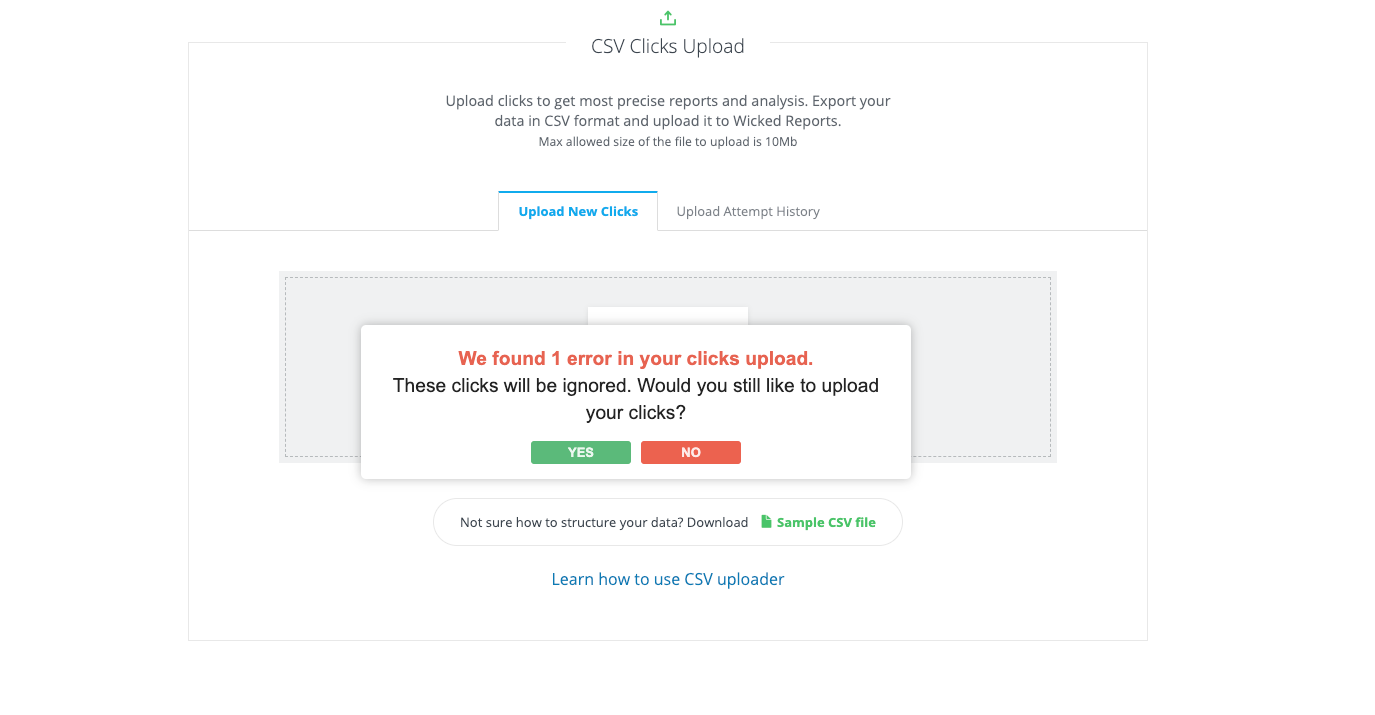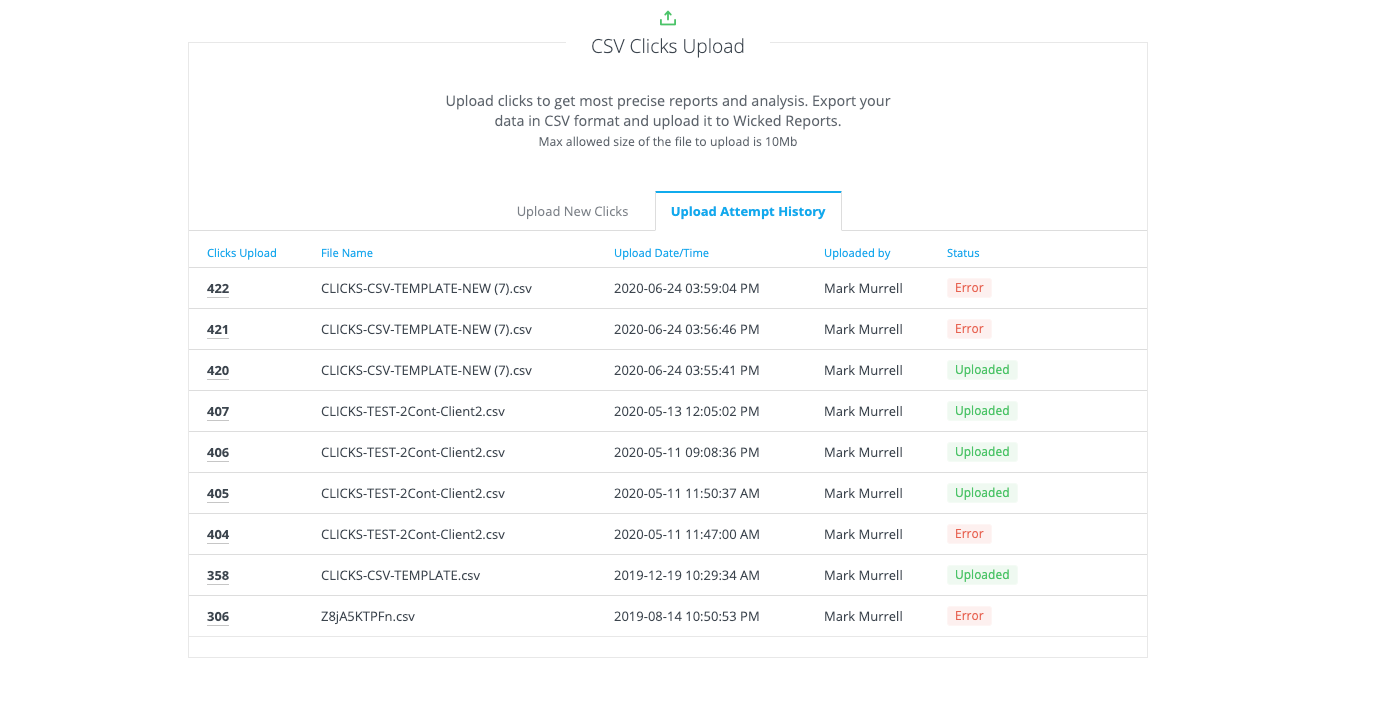How do I upload Custom Conversions via CSV?
Intro to Custom Conversions via CSV
When you want to record a Custom Conversions into a Contact's customer journey, there are a few possibilities to accomplish this: CSV, HTTP Post, Zapier, or API. This article focuses on uploading Custom Conversions via CSV.
Here are some examples of when you would want to upload a custom conversion:
- Scenario 1 - Custom Event
Case: You want to track how many people converted from any given marketing campaign to a nonpurchase event. In this case, you would use the Conversion Type of UNATTRIBUTED_CLICK. - Scenario 2 - Booked Meeting
Case: You want to track how many people (and who) booked a meeting, along with what ad platform was responsible for driving them to convert. In this case, you would use the Conversion Type of MEETING. - Scenario 3 - In-Person Demos
Case: You want to track how many people (and who) had an in-person demo with you and then see if those individual demos led to future sales. In this case, you would use the Conversion Type of LIVE_EVENT_DEMO.
You can also learn more about custom conversions in this help doc. Now, let's take a look at how to prepare your Custom Conversions for CSV upload.
How to format your Custom Conversions for CSV upload
When preparing your Custom Conversions for CSV upload, you'll want to make sure you've added all the required fields and formatted them correctly. If you have not prepared your file properly, you will receive an error message and you'll need to correct it before the file can process. In this section, we'll cover:
Please take a moment to read through this section so that you are aware of exactly how to prepare your file.
CSV Template:
Here is the CSV template, which you can use to enter your custom conversions and then upload via the "clicks" uploader tool: [CLICK HERE TO DOWNLOAD TEMPLATE]
The header row and column names are case-sensitive and must match the sample file.
Please use UTF-8 encoding for your CSV file, whenever possible.
Here are the required fields:
- EMAIL: Email of the lead for the conversion.
- CLICK TIME: This is a Date/Time setting to create the conversions against. You can use “NOW” for the current date/time or another date/time using this format: MM/DD/YYYY HH:MM (in 24-hour format)
- If 12-hour format, you must include AM/PM, and the correct date format would be: MM/DD/YYYY HH:MM AM/PM
- An example of a correctly formatted CLICK TIME field would be: "NOW" for the current date/time, "9/29/2016 20:15" if 24-hour, or "9/29/2016 8:15 PM" if 12-hour.
- TIMEZONE: Timezone of Date/Time provided. This would be the timezone your CRM is using, NOT the Timezone of the Contact.
-
- Examples: EST Timezone="UTC-5”, CST Timezone="UTC-6, MST Timezone=“UTC-7”
- Infusionsoft uses EST (UTC-5)
- If you are using a PresetOveride EXISTING_LEADS or ORDER_LAST_CLICK, you can use "UTC-0"
- Timezones change with Daylight Savings Time. For example, EST (Eastern Standard Time) is UTC-5 part of the year and UTC-4 part of the year. If you are setting up an automation that will run continuously, you will need to be aware of this and make sure your automation updates when Daylight Savings Time occurs.
- SOURCE: The Name of The Event
- CONTENT: The Name I wanted my Column Header to be called in Wicked Reports
- CONVERSION TYPE: The type of conversion being sent to Wicked.
The valid options are:- UNATTRIBUTED_CLICK
For example, you have a custom conversion that you'd like to send to Wicked Reports but do not know which conversion type to select. Choose this one, as it's ideal for most use cases.
- UNATTRIBUTED_CLICK
-
- HUBSPOT_MEETING
For example, you want to track how many HubSpot meetings you've had, who you have them with, and what campaigns drove this event conversion. - MEETING
For example, you want to track how many meetings you've had, who you have them with, and what campaigns drove this event conversion. - DOWNLOAD
For example, you want to track how many downloads you've had, who downloaded them, and what campaigns drove these users to download. - WEBINAR
For example, you want to track how many webinar submissions occurred, who submitted them, and what campaigns drove this event conversion.
- CHAT
For example, you want to track how many chats were initiated, who initiated them, and what campaign drove them to initiate a chat.
- LIVE_EVENT_DEMO
For example, you want to track how many live event demos were scheduled, who scheduled them, and if those individual demos led to purchases down the road.
- HUBSPOT_MEETING
Here are the optional fields:
- IP ADDRESS: The IP address of the user
- TIME OFFSET: The number of minutes to subtract from CLICK TIME.
- Example: If you know there is a 20-minute delay between when the click is created and when you want it to appear delayed, use 20 as your TIME OFFSET.
- TERM: additional event info
- MEDIUM: additional event info
- CAMPAIGN: additional event info
- OrderID: This field can be skipped. It is not needed for custom conversions.
- Wicked ID: This field can be skipped. It is not needed for custom conversions.
- Wicked Source: This field can be skipped. It is not needed for custom conversions.
Now that you've added all the required fields and formatted them correctly, you can go ahead and upload your custom conversions!
How to upload Custom Conversions via CSV
In this section, you'll learn how to upload your custom conversions into Wicked via CSV. Additionally, you'll learn some additional information related to the CSV uploader tool. Let's begin.
- Login to your Wicked Reports Account
- In your left navigation bar, go to the API & Uploaders Page
- Select the "Clicks Uploader" page
- When you open the page, you will see two tabs

- Upload New Clicks: You can drag and drop (or select) the .csv order file you want to upload. This uploader works for custom clicks and custom conversions.
- Upload Attempt History: You can see all the upload attempts you've made (successful and failed)
- On the Upload New Clicks tab, you will see a drop area where you can drop a .csv file (or click and select the file). Once dropped (or selected), Wicked Reports will attempt to validate all the custom conversions in the file.
- If NO errors are found, you will see all the custom conversions that were uploaded.
- If any errors are found, you will receive a message with the count of custom conversions that have errors.

- If you select "Yes", you will be shown the custom conversion to see which ones had errors. You will then be able to "Submit" the good custom conversions and ignore the bad ones.
- If you select "No", you will be taken back to the previous screen where you can select the file to re-upload after the proper edits have been made.
That's it! You've now completed your custom conversion upload. If you'd like to learn more about your custom conversions, such as how to see if your custom conversion has been processed, and where to view your custom conversions in Wicked Reports, then visit the Custom Conversions article for all that and more!
If you have any questions regarding custom conversions, then please review the FAQs below. If you find you still have questions after reading the FAQs, then reach out to the Wicked Reports support team via live chat, or by sending an email directly to support@wickedreports.com. We're always happy to help!
FAQs
- How do I view the clicks that I have already uploaded?
To see all of your CSV uploads, you can click on the tab "Upload Attempt History".
